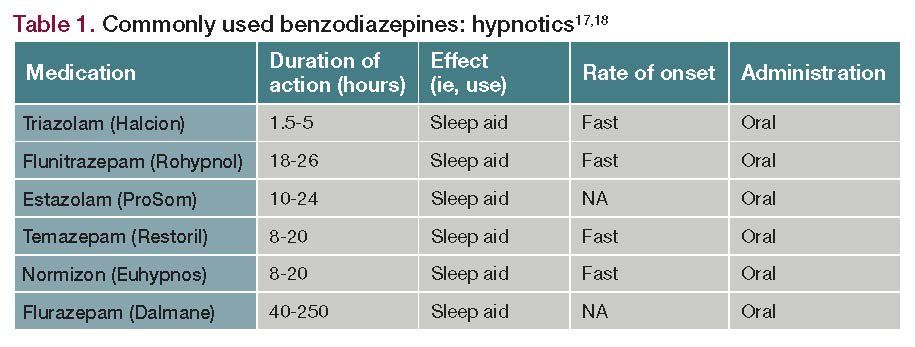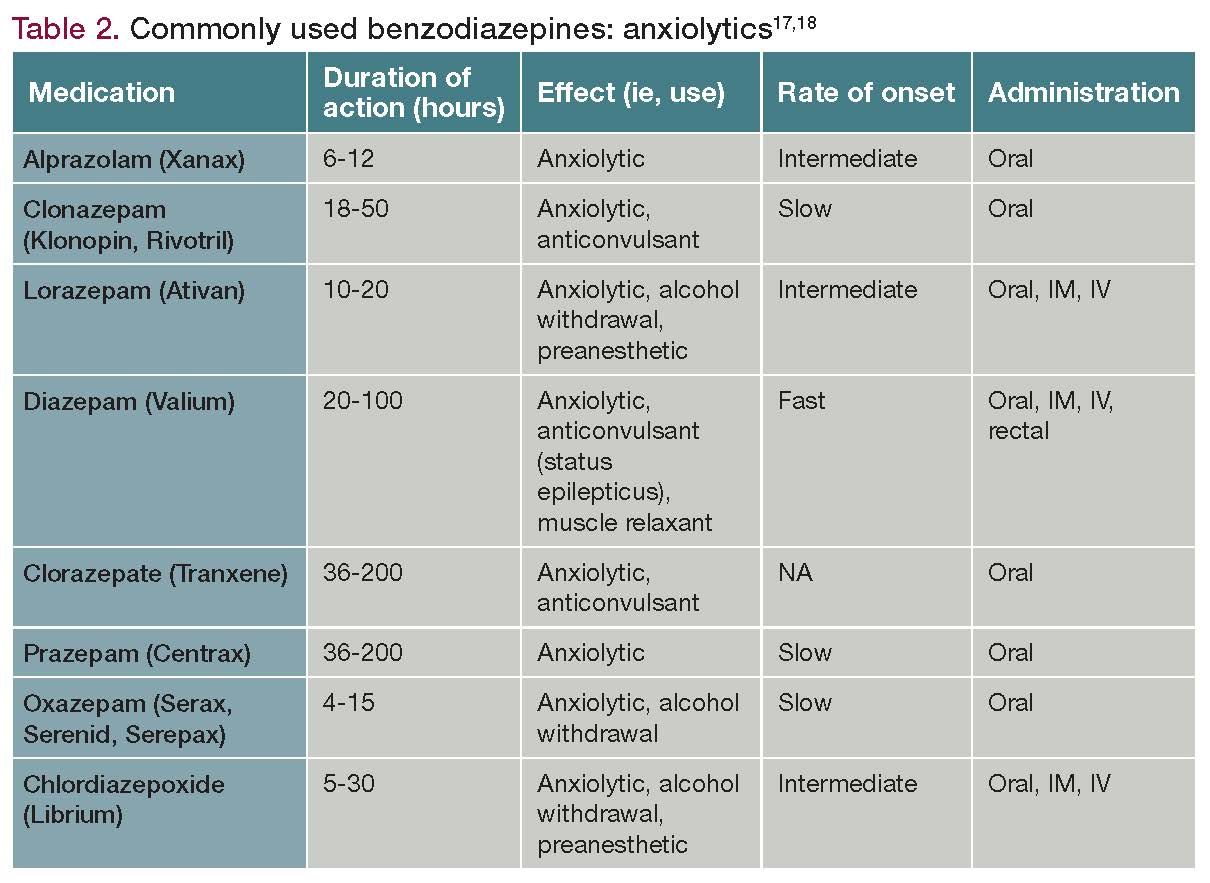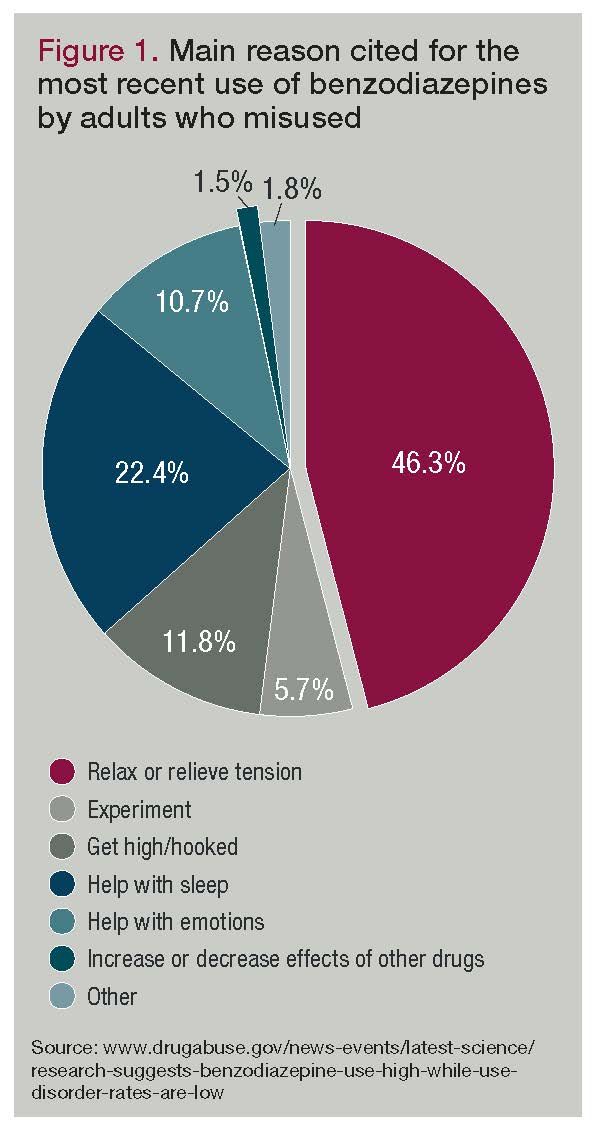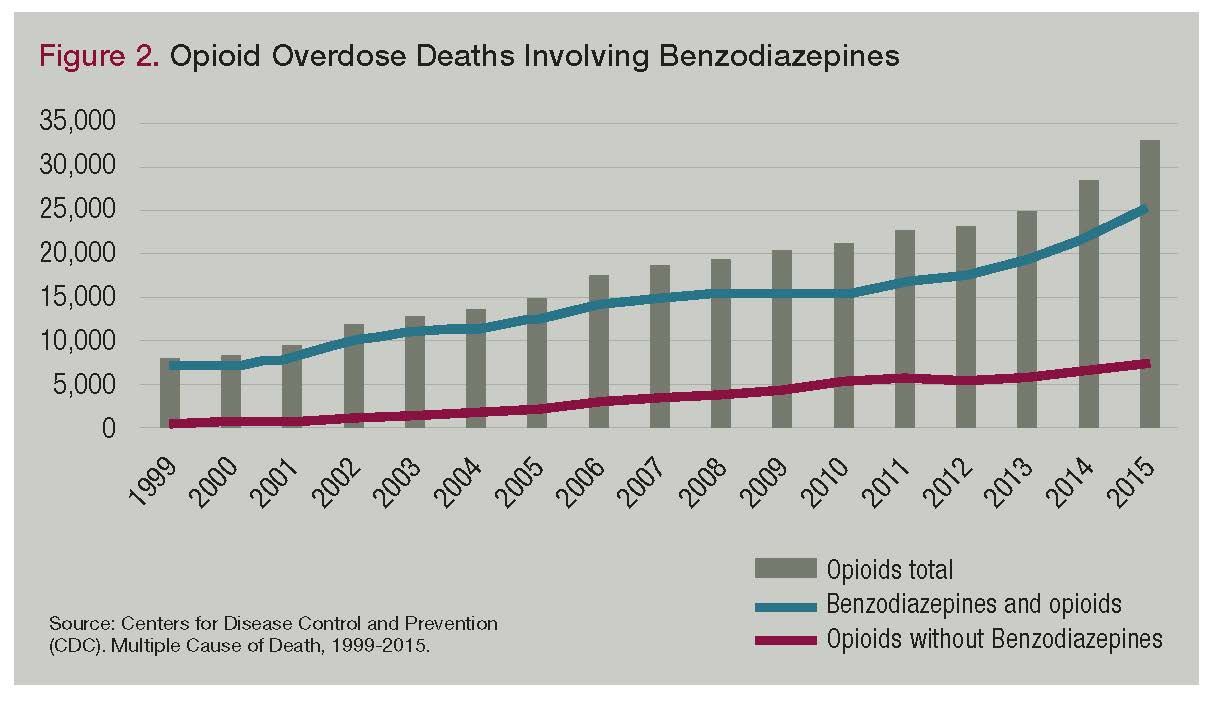Article
Understanding Benzodiazepines: Commonly Prescribed but Caution Advised
Author(s):
An addiction psychiatrist reviews benzodiazepines pharmacology and examines the risks and benefits of prescribing these medications.
Stephen A. Wyatt, DO

Table 1. Commonly used benzodiazepines: hypnotics

Table 2. Commonly used benzodiazepines: anxiolytics

Figure 1. Main reason cited for the most recent use of benzodiazepines by adults

Figure 2. Opioid Overdose Deaths Involving Benzodiazepines

Premiere Date: April 20, 2020
Expiration Date: November 20, 2021
This activity offers CE credits for:
1. Physicians (CME)
2. Other
All other clinicians either will receive a CME Attendance Certificate or may choose any of the types of CE credit being offered.
ACTIVITY GOAL
The goal of this activity is to provide an understanding of the class of medications known as benzodiazepines as well as when and how they can be used as part of treatment.
LEARNING OBJECTIVES
After engaging with the content of this CME activity, you should be better prepared to:
• Discuss the mechanisms of action of the various benzodiazepines.
• Consider the utility of benzodiazepine treatment.
• Recognize the indications for benzodiazepines.
TARGET AUDIENCE
This continuing medical education (CME) activity is intended for psychiatrists, psychologists, primary care physicians, physician assistants, nurse practitioners, and other health care professionals who seek to improve their care for patients with mental health disorders.
ACCREDITATION/CREDIT DESIGNATION/FINANCIAL SUPPORT
This activity has been planned and implemented in accordance with the accreditation requirements and policies of the Accreditation Council for Continuing Medical Education (ACCME) through the joint providership Physicians’ Education Resource®, LLC and Psychiatric Times. Physicians’ Education Resource®, LLC is accredited by the ACCME to provide continuing medical education for physicians.
Physicians’ Education Resource®, LLC designates this enduring material for a maximum of 1.5 AMA PRA Category 1 Credits™. Physicians should claim only the credit commensurate with the extent of their participation in the activity.
This activity is funded entirely by Physicians’ Education Resource®, LLC. No commercial support was received.
OFF-LABEL DISCLOSURE/DISCLAIMER
This CME activity may or may not discuss investigational, unapproved, or off-label use of drugs. Participants are advised to consult prescribing information for any products discussed. The information provided in this CME activity is for continuing medical education purposes only and is not meant to substitute for the independent clinical judgment of a physician relative to diagnostic or treatment options for a specific patient’s medical condition.
The opinions expressed in the content are solely those of the individual faculty members and do not reflect those of Physicians’ Education Resource®, LLC.
FACULTY, STAFF, AND PLANNERS’ DISCLOSURES
The author, Alan D. Kaye, MD, PhD (external peer reviewer), and the staff members of Physicians’ Education Resource®, LLC and Psychiatric Times have no relevant financial relationships with commercial interests.
John J. Miller, MD, external peer reviewer, reports that he is a consultant for Janssen and on the Speakers Bureau for Sunovion, Allergan, Teva, Janssen, Neurocrin, and Otsaka/Lundbeck.
For content-related questions email us at PTEditor@mmhgroup.com; for questions concerning the accreditation of this CME activity or how to claim credit, please contact info@gotoper.com and include Understanding Benzodiazepines: Commonly Prescribed but Caution Advised in the subject line.
HOW TO CLAIM CREDIT
Once you have read the article, please use the following URL to evaluate and request credit https://education.gotoper.com/activity/ptcme20apr. If you do not already have an account with PER® you will be prompted to create one. You must have an account to evaluate and request credit for this activity.
CASE VIGNETTES
A 40-year-old patient with a known history of anxiety associated with depression currently treated with a selective serotonin reuptake inhibitor presents after a personal trauma that took place a week ago. She reports that she has less than 4 hours of inconsistent sleep per night. There is a tearful description of an existential dread and anxiety.
A 67-year-old patient that you have been seeing for 10 years has a history of anxiety and depression. In recent months, the anxiety has been manageable and the depression stable; neither problem is causing social impairment. You have been treating the anxiety and depression with an SSRI and a high potency short-acting benzodiazepine (BZD) for 10 years. The patient is scheduled for a total knee replacement in a month and it is anticipated that she will need opioid pain medication. A discussion ensues concerning the potential complications of the coadministration of a BZD and an opioid. The mere discussion of tapering, much less discontinuing the BZD, results in significant distress and resistance.
These are two relatively common scenarios with which psychiatrists and other clinicians are confronted. In the first vignette, there may be a need for acute medical management and psychotherapy in treating the symptoms of distress. A BZD may be considered because it can provide the most rapid and effective relief.
The second vignette is more complicated. The patient has been on chronic BZD therapy and there are now compensatory changes, making the management of anxiety much more difficult.
Many clinical problems can be managed with BZDs. This variety of problems, and the fact the problems are often complex, make it important to understand the limitations and appropriate use of BZDs. This article serves as a review of BZD pharmacology and examines the risks and benefits of prescribing these medications. By way of disclosure, I am an addiction psychiatrist and have been challenged with some frequency by patients physically dependent on and/or misusing these medications who need an alternative care plan.
A little history
Chlordiazepoxide was synthesized in 1955 and the first BZD was brought to market in 1960 as chlordiazepoxide (Librium). Multiple other products with various molecular modifications followed. This class of medications quickly gained favor over the barbiturates because of their more favorable safety profile yet comparable efficacy as an anxiolytic and for reducing sleep onset latency.
Compared with barbiturates, BZDs result in less respiratory depression and a higher therapeutic index. Moreover, BZDs were thought to have less potential for misuse and dependence. BZDs were also found to have other clinical applications (eg, as a muscle relaxant, an anticonvulsant, a preanesthetic). By the mid-1970s they were among the most frequently prescribed medications.
In the 1980s, the similar nonbenzodiazepines or “Z drugs” (eg, zolpidem) were marketed for insomnia. These have all but completely taken the place of the BZDs as the drugs of choice in treating sleep onset latency problems.
Mechanism of action
With similar mechanisms, BZDs and the Z drugs continue to play an important role in multiple areas of health care. However, there have been concerns for several years surrounding the overprescribing of these medications and their adverse effects.
The problems associated with both medications include misuse and dependence, worsening cognition, potential for tolerance, rebound anxiety, and difficulties associated with withdrawal. There can be significant disinhibition typically resulting from the misuse of these medications in a vulnerable population, which is made worse when co-administered with other sedatives (including alcohol).
Most recently there have been more isolated concerns for two vulnerable populations: the elderly and patients taking or misusing opioids. An improved understanding of the mechanism of action of these medications can aid in the selection of a specific BZD and appropriate dosing, resulting in greater efficacy and an improved safety profile.
The mechanism of action of BZDs is dependent on the availability of γ-aminobutyric acid (GABA). This is key to its safety profile and different than both barbiturates and alcohol that work independent of GABA as sedatives in a variety of ways. One of these is by direct dose-dependent, prolonged hyperpolarization of the GABA receptor neuron, which can result in toxic levels of inhibition seen with alcohol and barbiturates. The BZDs work instead by binding to the GABA-A receptor at specific α subunit sites, increasing the affinity and efficiency of GABA as an agonist. This results in an influx of negatively charged chloride (CI-) ions and an increase in the frequency of the hyperpolarization of the calcium channel that leads to enhanced inhibition.
GABA receptors are found extensively and exclusively in the central nervous system. Clinically, we are most interested in the effects associated with the α1 and α2 subunits. The effect of agonist stimulation of the α1 subunit results in the hypnotic, retrograde amnestic and, in part, the anticonvulsant effects of these medications. The Z drugs target this specific GABA-A α1 subunit, resulting in only the sedation and hypnotic effects, although their use at higher, typically nonclinical, doses can result in antegrade amnesia.
The amnestic effects of the BZDs have a positive correlation to the lipophilicity of the medication associated with the speed in which the drug reaches the brain and GABA receptor. Greater lipophilicity, like that associated with midazolam, results in greater antegrade amnesia. Interestingly, it is the speed at which an individual gets intoxicated with alcohol that contributes to the potential for blackout. The combination of alcohol and benzodiazepines is associated with rapid intoxication and greater frequency of antegrade amnesia due to increased absorption of a BZD when taken with alcohol and the synergistic effects of the two drugs.
The α2 subunit is primarily involved in the anxiolytic effects and can play a role in muscle relaxation. The affinity of BZD to α2 receptors in the spinal cord and motor neurons is their primary role in muscle relaxation. Diazepam, typically at higher doses, is a good example of a muscle relaxant.
Treatment decisions
More than 21 different BZDs have been approved internationally with varying time to onset, action duration, and therapeutic effect. It should be noted that these medications are sedative hypnotics at certain dosages. The BZDs are all easily absorbed from the GI tract with high protein binding and lipid solubility; variations of absorption and lipid solubility influence the speed of onset.
Medications such as alprazolam and clonazepam are rapidly and efficiently absorbed resulting in a more rapid onset. Their comparatively higher affinity to the GABA receptor is associated with greater potency. The high lipophilic properties of midazolam, diazepam, and chlordiazepoxide are associated with rapid onset in the brain.
All the BZDs are rapidly absorbed orally but some can be administered by injection, depending on the pharmacokinetics of the specific medication. Lorazepam and midazolam are water soluble, resulting in less irritation when delivered by injection and are rapidly absorbed by intramuscular or intravascular administration. The duration of action after acute administration is most prominently affected by lipophilicity and volume of distribution of the drug. Whereas the duration of action with chronic administration is increasingly influenced by elimination half-life and the existence of active metabolites. Active metabolites result in the prolonged activity of chlordiazepoxide and diazepam. The health status of the patient (eg, underlying renal, hepatic disease), current tolerance to any BZD, and age also affect the dose response and are important to consider.
Because of the wide variability of potency and metabolites, the identification of these medications on urine toxicology screening is not straightforward. The primary metabolite identified by common immune assay point of care (POC) testing is oxazepam. Many of the benzodiazepines will be identified using point of care screening; however, some of the most commonly prescribed formulations will not.
Lorazepam is metabolized through glucuronidation. It is not metabolized hepatically, which is one of the reasons it is often used for alcohol withdrawal. Clonazepam and alprazolam are not metabolized to oxazepam and, as high potency BZDs, often fall under standard cut-off levels.
When using urine drug testing in clinical management, it is important to have working knowledge of the point of care test to know which BZD can be identified and use confirmatory testing-gas or liquid chromatography mass spectroscopy-for greater specificity. Urine screening for BZDs can have both false positive and false negative results. In general, point of care testing should always be used in conjunction with clinical presentation and when the results are in conflict; use confirmatory testing before making a judgement. Understanding the pharmacology and pharmacokinetics of the various benzodiazepines can help in choosing the appropriate medication for the treatment of sleep disorders, anxiety, and agitation (Table 1 andTable 2).
Specific indications
Sleep onset latency
The use of BZDs for reduction in sleep onset latency is very effective. All the GABA agonist medications can be effective in establishing sleep and for many patients will have excellent short-term utility. Initially the FDA only approved them for short-term use-7 to 14 days. However, in 2005 the recommendation was updated once it was recognized that patients can have chronic insomnia; if the medications are monitored appropriately there can be continued efficacy, better tolerance, easier withdrawal, and less misuse.
Z-drugs were considered to have less risk of dependency and misuse than standard BZDs, but unfortunately this has not always been the case. Another problem is that extended use can result in adverse effects on sleep architecture: affecting the quality of restorative sleep and being responsible for rebound sleep difficulties following withdrawal. Before prescribing Z-drugs, patients should be evaluated for the potential cause of sleep instability with attention paid to underlying physical and behavioral health disorders such as substance misuse, movement disorders, and parasomnias.
Both BZDs and Z drugs can result in slowing respiration and should be used cautiously if at all in the elderly and in patients who have an underlying respiratory problem. Patients should also be encouraged to use healthy sleep hygiene before initiating these medications.
Posttraumatic stress disorder
Most frequently, BZDs are prescribed for their anxiolytic effects. They work rapidly and effectively in anxious patients. In patients with PTSD, BZDs can reduce anxiety and improve sleep. However, their efficacy in preventing PTSD or treating the core symptoms of PTSD has not been established.1 It is also important to be attentive to the potential increase of comorbid substance use disorder. Prescribing BZDs to patients with a substance use comorbidity complicates care and can worsen outcomes.
Although these are often troubled patients with complex physical and mental health problems, clinicians may need to discontinue the BZD because of some of the more common adverse effects (eg, worsening cognition, comorbid respiratory disease, increased risks associated with opioid or alcohol use). This can be difficult and met with resistance from patients who can experience rebound anxiety. BZDs are used most effectively as a short-term bridge in assisting the transition to more definitive medication management. Once patients are better stabilized, the BZD is used only as needed.2,3
Anxiety and panic disorders
The efficacy of SSRIs, serotonin-norepinephrine reuptake inhibitors, and tricyclics in the treatment of anxiety disorders is comparable to that of BZDs; as such, they are considered the medications of choice.4 The introduction of high potency, rapid onset formulations (eg, lorazepam, clonazepam, and alprazolam) have added to BZD utility in acute treatment. Choosing a medication is based on adverse effects and co-occurring disorders.
The precautions and complications of using BZDs long term for panic disorders are similar to those of other behavioral health problems. BZDs are most effectively used acutely, as needed for significant panic episodes in patients at low risk for misuse. Evidence suggests use of a BZD as an initial 2- to 3-week bridge to starting treatment with an SSRI or SNRI.5,6 When used this way, there is less potential for problems on discontinuation. Short-acting alprazolam requires redosing every 4 to 6 hours. And after regular daily dosing for 1 to 4 months, there is most often rebound anxiety. This rebound results in the patient’s belief that the rebound anxiety is their baseline anxiety and they become reluctant to consider discontinuation. This scenario can contribute to the development of dependence.
The addictive potential of a drug is positively correlated to the rate of onset of a positive effect. The rate of the positive effect is dependent on the pharmacokinetics of the drug and/or the route of administration. Alprazolam is rapidly and efficiently absorbed throughout the CNS, thus increasing its addictive potential. More dopamine is released with alprazolam than with other BZDs, thereby increasing the sense of pleasure on administration and potential for dependency. For these reasons, it is often difficult to switch from alprazolam to an alternative longer-acting BZD.7,8
Clonazepam, is a longer-acting BZD with a wider dosing schedule. As such, there is less rebound anxiety on delayed administration. Therefore, clonazepam may have greater utility for a longer period of daily administration but is not as effective in the acute panic setting.
Other indications
Another area of important clinical use of BZDs is in the agitated patient with or without psychosis. In this case, BZDs are often used with an antipsychotic medication. Lorazepam is most often the drug of choice for this purpose because it is easily administered either orally or parenterally. However, there is no evidence for efficacy with BZD monotherapy; although they can be effective in treating some episodes of catatonia as monotherapy.9
Precautions to consider
BZDs continue to be one of the most commonly prescribed medications. Their long-term use has continued to rise even though the evidence for long-term efficacy has not been established.10 This has contributed to greater overall availability and nonprescription use (Figure 1). Although the recreational use of BZDs alone is not common, concurrent use with other prescribed and non-prescribed drugs is quite common.11 BZDs are used in conjunction with other drugs to augment euphoria, notably with opioids and alcohol, or reduce agitation or anxiety and promote sleep when using stimulants (eg, cocaine, methamphetamines, cannabis).
Using BZDs with alcohol can result in harmful disinhibition and retrograde amnesia. The combination of opioids and BZDs plays a significant role in the incidence of lethal overdose in the US (Figure 2). BZD-related overdose mortality has risen dramatically, from 0.6 per 100,000 adults in 1999 to 4.4 per 100,000 in 2016. Emergency department visits because of BZD effects has been estimated to have risen from 2.6% in 1990 to 7.4% in 2015.12
When considering tapering a patient, it is important to remember that significant symptoms associated with withdrawal are not typically seen unless the patient has been taking a BZD on a consistent basis for more than 1 to 4 months. There can often be significant withdrawal problems, primarily rebound anxiety, but may also include manifestations of seizure disorder. In a controlled setting, withdrawal can be more rapid, often with the use of phenobarbital or carbamazepine.13,14 For outpatients, a slow taper is best.
A short-acting BZD can be switched to a long-acting form at an equivalent dose. For example, patients on 6-mg alprazolam daily can be switched to an equivalent dose of 120-mg diazepam over a few weeks. The long half-life of diazepam and its active metabolites will vary depending on the duration of time the patient has been on the medication but will allow for a soft taper over many weeks. However, keep in mind alprazolam is a triazolo-benzodiazepine and is not fully covered by nonâtriazolo-benzodiazepines such as diazepam, which might result in some rebound anxiety.
A conservative, widely used schedule, the Ashton Protocol advocates for a diazepam taper at a rate of 10 mg per week or longer, resulting in safe and effective withdrawal. Withdrawal with other long-acting BZDs can be achieved similarly.15,16
Conclusion
It is important to recognize that the disadvantages associated with BZDs are most closely associated with their long-term use. We should be sensitive to prescribing BZDs to the elderly, who can experience greater sedation due to a slower metabolism, greater sensitivity to cognitive impairment, and falls and fractures, as well as to patients with a current or past history of a substance use disorder.
Because BZDs are primarily short-term acute treatment modalities, it is important to consider the use of a more definitive medication. Continuous monitoring is needed to gauge the patient’s need for a BZD while considering a switch to an alternative evidence-based medication for long-term treatment.
If the patient no longer needs or takes the BZD, they should be advised to properly dispose of any remaining medications. As seen with the recent opioid epidemic, the number of pills in the community drives misuse. Patients need to understand that controlled substances are prescribed for a particular problem and their use for any other purpose is misuse. Sharing BZDs can be dangerous and is illegal. As specialists, we can model the safe and effective use of BZDs for other health care providers.
CME POST-TEST
Posttests, credit request forms, and activity evaluations must be completed online at at https://education.gotoper.com/activity/ptcme20apr (requires free account activation), and participants can print their certificate or statement of credit immediately (80% pass rate required). This website supports all browsers. For PER’s privacy policy, please visit https://www.gotoper.com/privacy.
PLEASE NOTE THAT THE POSTTEST IS AVAILABLE ONLINE ONLY ON THE 20TH OF THE MONTH OF ACTIVITY ISSUE AND FOR 18 MONTHS AFTER.
Need Additional CME Credit?
Check Out These Free CME Activities-
Substance Use Disorders in Crisis Settings: Engagement, Assessment, and Intervention Approaches
Kenneth Minkoff, MD
Expiration Date: July 20, 2020
Autism in Adulthood: Widespread, Invisible, Neglected, Misunderstood-Not Our Problem?
Traolach S. Brugha, MD
Expiration Date: August 20, 2020
References:
1. Gelpin E, Bonne O, Peri T, et al. Treatment of recent trauma survivors with benzodiazepines: a prospective study. J Clin Psychiatry. 1996;57:390-394.
2. Kosten TR, Fontana A, Sernyak MJ, Rosenheck R. Benzodiazepine use in posttraumatic stress disorder among veterans with substance abuse. J Nerv Ment Dis. 2000;188:454-459.
3. Stein DJ, Ipser JC, Seedat S. Pharmacotherapy for post-traumatic stress disorder (PTSD). Cochrane Database Syst Rev. 2006;1:CD002795.
4. Benedek DM, Friedman MJ, Zatzick D, Ursano RJ. Guideline watch: practice guideline for the treatment of patients with acute stress disorder and posttraumatic stress disorder. APA Practice Guidelines. March 2009.
5. Stein DJ. Comorbidity in generalized anxiety disorder: impact and implications. J Clin Psychiatry. 2001;62(Suppl 11):29-36.
6. Bushnell GA, Stürmer T, Gaynes BN, et al. Simultaneous antidepressant and benzodiazepine new use and subsequent long-term benzodiazepine use in adults with depression, United States, 2001-2014. JAMA Psychiatry. 2017;74:747-755.
7. National Institute on Drug Abuse. Well-Known Mechanism Underlies Benzodiazepines’ Addictive Properties. NIDA Notes. 2012.
8. Ait-Daoud N, Hamby AS, Sharma S, Blevins D. A review of alprazolam use, misuse, and withdrawal. J Addict Med. 2018;12:4-10.
9. Hughes DH, Kleespies PM. Treating aggression in the psychiatric emergency service. J Clin Psychiatry. 2003;64(Suppl 4):10-15.
10. Dell’Osso B, Albert U, Atti AR, et al. Bridging the gap between education and appropriate use of benzodiazepines in psychiatric clinical practice. Neuropsychiatr Dis Treat. 2015;11:1885-1909.
11. Olfson M, King M, Schoenbaum M. Benzodiazepine use in the United States. JAMA Psychiatry. December 2014; Epub.
12. Agarwal SD, Landon BE. Patterns in outpatient benzodiazepine prescribing in the United States. JAMA Network. 2019;2:e187399.
13. Kawasaki SS, Jacapraro JS, Rastegar DA. Safety and effectiveness of a fixed-dose phenobarbital protocol for inpatient benzodiazepine detoxification. J Subst Abuse Treat. 2012;43:331-334.
14. Fatséas M, Lavie E, Auriacombe M. Pharmacological interventions for benzodiazepine mono-dependence management in outpatient settings. Cochrane Database Syst Rev. 2006;19;CD005194.
15. Soyka M. Treatment of benzodiazepine dependence. N Engl J Med. 2017;376:1147-1157.
16. Ashton CH. Benzodiazepines: how they work and how to withdraw. The Ashton Manual, revised August 2002.
17. Barash PG, Cullen BF, Stoelting RK, et al. Clinical Anesthesia, 6th ed. Philadelphia. PA: Wolters Kluwer/Lippincott Williams and Wilkins; 2009: 586-588.
18. Shanahan J, Lebowitz H. Goodman and Gilman’s The Pharmacological Basis of Therapeutics, Hypnotics, and Sedatives, Chapter 19. New York: McGraw Hill Education; 2018.






